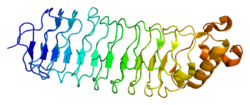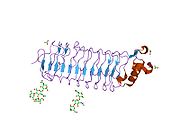- Reticulon 4 receptor
-
Reticulon 4 receptor 
PDB rendering based on 1ozn.Available structures PDB 1OZN, 1P8T Identifiers Symbols RTN4R; NGR; NOGOR External IDs OMIM: 605566 MGI: 2136886 HomoloGene: 11299 GeneCards: RTN4R Gene Gene Ontology Molecular function • receptor activity
• protein bindingCellular component • endoplasmic reticulum
• plasma membrane
• cell surface
• membrane
• anchored to membraneBiological process • axonogenesis
• nerve growth factor receptor signaling pathway
• regulation of axonogenesis
• negative regulation of axonogenesisSources: Amigo / QuickGO Orthologs Species Human Mouse Entrez 65078 65079 Ensembl ENSG00000040608 ENSMUSG00000043811 UniProt Q9BZR6 Q99PI8 RefSeq (mRNA) NM_023004 NM_022982.2 RefSeq (protein) NP_075380 NP_075358.1 Location (UCSC) Chr 22:
20.23 – 20.27 MbChr 16:
18.13 – 18.15 MbPubMed search [1] [2] Reticulon 4 receptor (RTN4R) also known as Nogo-66 Receptor (NgR) is a protein which in humans is encoded by the RTN4R gene.[1] This gene encodes the receptor for reticulon 4, oligodendrocytemyelin glycoprotein and myelin-associated glycoprotein. This receptor mediates axonal growth inhibition and may play a role in regulating axonal regeneration and plasticity in the adult central nervous system.[1]
Contents
Function
The Nogo-66 Receptor (NgR) is a high affinity binding receptor for a region of Nogo, a myelin associated protein that inhibits axon outgrowth. NgR was identified by Strittmatter and colleagues[2] using an expression cloning strategy.
NgR is implicated in neuronal plasticity and regeneration. Its relative importance in mediating myelin inhibition in vitro and in vivo is currently under intense investigation, since this protein might be a good drug target for treatment of various neurological conditions such as spinal cord injury and stroke.
Nogo pathway: rho kinase
While the entire pathway is not fully understood, the relationship between NgR and neuronal outgrowth has been fleshed out. NgR is a membrane protein that, when bound to neurite outgrowth inhibitor (Nogo), inhibits cell growth through the activation of rho kinase (ROCK).
NgR activation of p75
It was known that NgR, Nogo, and another membrane receptor called p75 were involved in inhibiting neurite outgrowth. Through a variety of experimental procedures Wang et al.[3] were able to identify the biochemical relationship between NgR and p75. First, it was observed that when p75 was knocked out in mice, outgrowth inhibition was no longer seen. Completing binding assays and co-immunoprecipitations revealed that p75 and NgR were not bound to each other through the cellular membrane. Mutating either p75 or NgR, however, resulted in truncated protein that would help reveal the binding interactions. When the extracellular domains of the receptors were removed no outgrowth inhibition was seen. This would suggest that the receptors interact extracellularly. Furthermore, it was reaffirmed that Nogo and myelin-associated gylcoprotein (MAG) bind NgR and not p75. The receptor p75 lacks a binding domain for either of these proteins.
Activation of rho protein
The work of Kaplan and Miller<[4] shows that there is an interaction between the p75/NgR receptors and Rho GDP dissociation inhibitor (Rho-GDI). Kaplan and Miller show that when Nogo is bound to NgR, Rho-GDI is associated with p75. When Rho-GDI is drawn to p75 it is no longer bound to Rho-GDP. This allows for GTP to be exchanged for GDP activating the Rho protein. Rho-GTP, a Rho GTPase, then activates ROCK which phosphorylates other proteins which inhibit neurite outgrowth. When Nogo is not bound to NgR, p75 is not activated and Rho-GDI remains bound to Rho-GDP. The Rho protein remains bound with GDP and remains inactive. ROCK therefore does not become activated and cannot change transcription patterns to inhibit neuronal outgrowth.
Therapeutic Inhibition
It is reasonable that inhibition of the above mechanism could aid the recovery of those suffering from spinal cord injuries. One such therapy is currently in clinical trials. The drug, called Cethrin, is produced by a group called Alseres. Cethrin is a ROCK inhibitor and therefore acts in the above pathway to prevent the activation of ROCK so neurite outgrowth can occur.[5][6] Cethrin is applied as a paste to the site of injury during decompression surgery.
See also
References
- ^ a b "Entrez Gene: RTN4R reticulon 4 receptor". http://www.ncbi.nlm.nih.gov/sites/entrez?Db=gene&Cmd=ShowDetailView&TermToSearch=65078.
- ^ Fournier AE, GrandPre T, Strittmatter SM (January 2001). "Identification of a receptor mediating Nogo-66 inhibition of axonal regeneration". Nature 409 (6818): 341–6. doi:10.1038/35053072. PMID 11201742.
- ^ Wang KC, Kim JA, Sivasankaran R, Segal R, He Z (November 2002). "P75 interacts with the Nogo receptor as a co-receptor for Nogo, MAG and OMgp". Nature 420 (6911): 74–8. doi:10.1038/nature01176. PMID 12422217.
- ^ Kaplan DR, Miller FD (May 2003). "Axon growth inhibition: signals from the p75 neurotrophin receptor". Nat. Neurosci. 6 (5): 435–6. doi:10.1038/nn0503-435. PMID 12715005.
- ^ Baptiste DC, Fehlings MG (2006). "Pharmacological approaches to repair the injured spinal cord". J. Neurotrauma 23 (3-4): 318–34. doi:10.1089/neu.2006.23.318. PMID 16629619.
- ^ Baptiste DC, Fehlings MG (2007). "Update on the treatment of spinal cord injury". Prog. Brain Res. 161: 217–33. doi:10.1016/S0079-6123(06)61015-7. PMID 17618980.
Further reading
- Ng CE, Tang BL (2002). "Nogos and the Nogo-66 receptor: factors inhibiting CNS neuron regeneration.". J. Neurosci. Res. 67 (5): 559–65. doi:10.1002/jnr.10134. PMID 11891768.
- Ferraro GB (2007). "Refining our understanding of NgR1 function during myelin inhibition.". J. Neurosci. 27 (43): 11451–2. doi:10.1523/JNEUROSCI.3419-07.2007. PMID 17959786.
- Dunham I, Shimizu N, Roe BA, et al. (1999). "The DNA sequence of human chromosome 22.". Nature 402 (6761): 489–95. doi:10.1038/990031. PMID 10591208.
- Hartley JL, Temple GF, Brasch MA (2001). "DNA cloning using in vitro site-specific recombination.". Genome Res. 10 (11): 1788–95. doi:10.1101/gr.143000. PMC 310948. PMID 11076863. http://www.pubmedcentral.nih.gov/articlerender.fcgi?tool=pmcentrez&artid=310948.
- Fournier AE, GrandPre T, Strittmatter SM (2001). "Identification of a receptor mediating Nogo-66 inhibition of axonal regeneration.". Nature 409 (6818): 341–6. doi:10.1038/35053072. PMID 11201742.
- Wiemann S, Weil B, Wellenreuther R, et al. (2001). "Toward a catalog of human genes and proteins: sequencing and analysis of 500 novel complete protein coding human cDNAs.". Genome Res. 11 (3): 422–35. doi:10.1101/gr.GR1547R. PMC 311072. PMID 11230166. http://www.pubmedcentral.nih.gov/articlerender.fcgi?tool=pmcentrez&artid=311072.
- Simpson JC, Wellenreuther R, Poustka A, et al. (2001). "Systematic subcellular localization of novel proteins identified by large-scale cDNA sequencing.". EMBO Rep. 1 (3): 287–92. doi:10.1093/embo-reports/kvd058. PMC 1083732. PMID 11256614. http://www.pubmedcentral.nih.gov/articlerender.fcgi?tool=pmcentrez&artid=1083732.
- GrandPré T, Li S, Strittmatter SM (2002). "Nogo-66 receptor antagonist peptide promotes axonal regeneration.". Nature 417 (6888): 547–51. doi:10.1038/417547a. PMID 12037567.
- Wang KC, Koprivica V, Kim JA, et al. (2002). "Oligodendrocyte-myelin glycoprotein is a Nogo receptor ligand that inhibits neurite outgrowth.". Nature 417 (6892): 941–4. doi:10.1038/nature00867. PMID 12068310.
- Liu BP, Fournier A, GrandPré T, Strittmatter SM (2002). "Myelin-associated glycoprotein as a functional ligand for the Nogo-66 receptor.". Science 297 (5584): 1190–3. doi:10.1126/science.1073031. PMID 12089450.
- Domeniconi M, Cao Z, Spencer T, et al. (2002). "Myelin-associated glycoprotein interacts with the Nogo66 receptor to inhibit neurite outgrowth.". Neuron 35 (2): 283–90. doi:10.1016/S0896-6273(02)00770-5. PMID 12160746.
- Woolf CJ, Bloechlinger S (2002). "Neuroscience. It takes more than two to Nogo.". Science 297 (5584): 1132–4. doi:10.1126/science.1076247. PMID 12183616.
- Josephson A, Trifunovski A, Widmer HR, et al. (2002). "Nogo-receptor gene activity: cellular localization and developmental regulation of mRNA in mice and humans.". J. Comp. Neurol. 453 (3): 292–304. doi:10.1002/cne.10408. PMID 12378589.
- Wang KC, Kim JA, Sivasankaran R, et al. (2002). "P75 interacts with the Nogo receptor as a co-receptor for Nogo, MAG and OMgp.". Nature 420 (6911): 74–8. doi:10.1038/nature01176. PMID 12422217.
- Strausberg RL, Feingold EA, Grouse LH, et al. (2003). "Generation and initial analysis of more than 15,000 full-length human and mouse cDNA sequences.". Proc. Natl. Acad. Sci. U.S.A. 99 (26): 16899–903. doi:10.1073/pnas.242603899. PMC 139241. PMID 12477932. http://www.pubmedcentral.nih.gov/articlerender.fcgi?tool=pmcentrez&artid=139241.
- He XL, Bazan JF, McDermott G, et al. (2003). "Structure of the Nogo receptor ectodomain: a recognition module implicated in myelin inhibition.". Neuron 38 (2): 177–85. doi:10.1016/S0896-6273(03)00232-0. PMID 12718853.
- Barton WA, Liu BP, Tzvetkova D, et al. (2003). "Structure and axon outgrowth inhibitor binding of the Nogo-66 receptor and related proteins.". EMBO J. 22 (13): 3291–302. doi:10.1093/emboj/cdg325. PMC 165649. PMID 12839991. http://www.pubmedcentral.nih.gov/articlerender.fcgi?tool=pmcentrez&artid=165649.
- Clark HF, Gurney AL, Abaya E, et al. (2003). "The secreted protein discovery initiative (SPDI), a large-scale effort to identify novel human secreted and transmembrane proteins: a bioinformatics assessment.". Genome Res. 13 (10): 2265–70. doi:10.1101/gr.1293003. PMC 403697. PMID 12975309. http://www.pubmedcentral.nih.gov/articlerender.fcgi?tool=pmcentrez&artid=403697.
- Ota T, Suzuki Y, Nishikawa T, et al. (2004). "Complete sequencing and characterization of 21,243 full-length human cDNAs.". Nat. Genet. 36 (1): 40–5. doi:10.1038/ng1285. PMID 14702039.
PDB gallery Categories:- Human proteins
- Receptors
Wikimedia Foundation. 2010.


